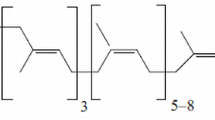Abstract
Antitumor activity ofLactobacillus casei YIT 9018 (LC9018) was demonstrated by intralesional (i. 1.) or intravenous (i. v.) administration into tumor-bearing mice which were inoculated with methylcholanthrene-induced fibrosarcoma (Meth A) or Kirsten murine sarcoma virus-transformed tumor (K234) cells. Its activity was significantly superior to the activity of two other species of lactobacilli but was nearly the same as that ofCorynebacterium parvum orMycobacterium bovis Bacille Calmette-Guérin (BCG). I. l. or i. v. administration of LC9018 into the tumor bearers caused local transient swelling or hepatosplenomegaly but did not cause other pronounced lesions. There was no significant difference in the degree of hepatosplenomegaly in LC9018 and that in other immunopotentiators. In mice whose tumors had regressed as a result of administration of LC9018 or the other immunopotentiators, the phytohemagglutinin P (PHA-P) response of the spleen cells was less than that of mice whose tumors progressed, and approached the normal level. The PHA-P response of popliteal lymph node cells proximal to the tumor lesion was fairly low compared with the splenic PHA-P response and there was no difference between the lymphocytes from mice whose tumors had regressed or progressed. Adjuvant activity of LC9018 in inducing tumor immunity was demonstrated by administering a mixture of LC9018 and Meth A cells to mice. This adjuvant activity was of the same efficiency as that ofC. parvum and BCG. The presence of the antitumor activity of LC9018 in cell wall components was deduced from fact that removal of its cell wall by endo-N-acetylmuramidase (M-1 enzyme) abolished the activity. The possible availability of LC9018 for immunotherapy of tumors is discussed.
Similar content being viewed by others
References
Adler WH, Takiguchi T, Smith RT (1971) Phytohemagglutinin unresponsiveness in mouse spleen cells induced by methylcholanthrene sarcomas. Cancer Res 31: 864–867
Azuma I, Sugimura K, Taniyama T, Yamawaki M, Yamamura Y, Kusumoto S, Okada S, Shiba T (1976) Adjuvant activity of mycobacterial fractions: Adjuvant activity of synthetic N-acetylmuramyl-dipeptide and the related compounds. Infect Immun 14:18–27
Bloksma N, DeHeer E, Vadijk H, Willers JM (1979) Adjuvanticity of lactobacilli. Clin Exp Immunol 37:367–375
Bloksma N, Ettekoven H, Hofhuis FM, Noorle-Jansen L, DeReuver MJ, Kreeftenberg JG, Willers JM (1981) Effects of lactobacilli on parameters of non-specific resistance of mice. Med Microbiol Immunol 170:45–53
Davies M (1983) Phase variations in the modulations of the immune response. Immunol Today 4:103–106
Dye ES, North RJ, Mills CD (1981) Mechanisms of anti-tumor action ofCoryne-bacterium parvum. 1. Potentiated tumor-specific immunity and its therapeutic limitations. J Exp Med 154:609–620
Efthymiou C, Hansen PA (1962) An antigenic analysis ofLactobacillus acidophilus. J Infect Dis 110:258–267
Fisher B, Rubin H, Saffer E, Wolmark N (1976) The effect ofCorynebacterium parvum in combination with 5-fluorouracil, L-phenylalanine mustard or methotrexate on the inhibition of tumor growth. Cancer Res 36:2714–2719
Gillette RW, Boone CW (1973) Changes in phytohemagglutinin response due to presence of tumors. J Natl Cancer Inst 50:1391–1393
Hatanaka M, Klein R, Toni R, Walker J, Gilden R (1973) Mutants of nonproducer cell lines transformed by murine sarcoma viruses. J Exp Med 138:356–372
Kamo I, Friedman H (1977) Immunosuppression and the role of suppressive factors in cancer. Adv Cancer Res 25:271–321
Kato I, Kobayashi S, Yokokura T, Mutai M (1981) Antitumor activity ofLactobacillus casei in mice. Gann 72:517–523
Kato I, Yokokua T, Mutai M (1983) Macrophage activation byLactobacillus casei in mice. Microbiol Immunol 27:611–618
Leclerc C, Juy D, Bourgeois E, Chedid L (1979) In vivo regulation of humoral and cellular immune responses of mice by a synthetic adjuvant, N-acetyl-muramyl-L-alanyl-D-isoglutamine, muramyl dipeptide for MDP. Cell Immunol 45:199–206
Lieberman R, Wybran J, Epstein W (1975) The immunologic and histopathologic changes of BCG-mediated tumor regression in patients with malignant melanoma. Cancer 35:765–777
Milas L, Scott MT (1978) Antitumor activity ofCorynebacterium parvum. Adv Cancer Res 26:257–306
Mitsuoka T (1969) Vergleichende Untersuchungen über die Laktobazillen aus den Faces von Menschen, Schweinen und Hühnern. Zentralbl Bakteriol (Orig. A) 210: 32–51
Piessens WF, Campbell M, Churchill WH (1977) Inhibition or enhancement of rat mammary tumors dependent on dose of BCG. J Natl Cancer Inst 59:207–211
Reddy GV, Friend BA, Shahani KM, Farmer RE (1983) Antitumor activity of yogurt components. J Food Protect 46:8–11
Reddy GV, Shahani KM, Banerjee MR (1973) Inhibitory effect of yogurt on Ehrlich ascites tumor-cell proliferation. J Natl Cancer Inst 50:815–817
Scott MT (1974)Corynebacterium parvum as a therapeutic antitumor agent in mice. 11. Local injection. J Natl Cancer Inst 53:861–865
Shahani KM, Friend BA, Bailey PJ (1983) Antitumor activity of fermented colostrum and milk. J Food Protect 46:385–386
Shimizu T, Mifuchi I, Yokokura T (1981) Mitogenic effect of lactobacilli on murine lymphocytes. Chem Pharm Bull 29:3731–3734
Taniyama T, Watanabe T, Azuma I, Ymamura Y (1974) Adjuvant activity of mycobacterial fractions II. In vitro adjuvant activity of cell walls of mycobacteria, nocardia and corynebacteria. Jpn J Microbiol 18:415–426
Tomochika K, Funabashi M, Nagata A, Fujii T, Kanemasa Y (1982) Protoplast formation ofLactobacillus casei induced by Endo-N-acetylmuramidase. Jpn J Bacteriol 37:777–785
Yasumoto K, Manabe H, Yanagawa E, Nagano N, Ueda H, Hirota N, Ohta M, Nomoto K, Azuma I, Yamamura Y (1979) Nonspecific adjuvant immunotherapy of lung cancer with cell wall skeleton ofMycobacterium bovis Bacillus Calmette-Guérin. Cancer Res 39:3262–3267
Yasutake N, Kato I, Ohwaki M, Yokokura T, Mutai M (1984) Host-mediated antitumor activity ofLactobacillus casei in mice. Gann 75:72–80
Author information
Authors and Affiliations
Rights and permissions
About this article
Cite this article
Yasutake, N., Ohwaki, M., Yokokura, T. et al. Comparison of antitumor activity ofLactobacillus casei with other bacterial immunopotentiators. Med Microbiol Immunol 173, 113–125 (1984). https://doi.org/10.1007/BF02123760
Received:
Issue Date:
DOI: https://doi.org/10.1007/BF02123760



